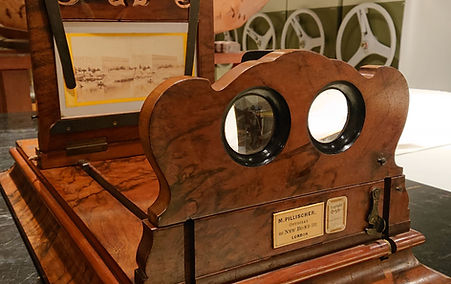
The Stereograph Collection at Kyoto University
About stereographs
& stereoscopes
A stereograph is also called by other names, such as a stereogram, stereo card, or stereo view. Stereographs were a popular photographic medium in Europe in the mid-1800s, and became widely distributed in the United States by the 1880s. Many companies were involved in the production of stereographs. Some of the reasons for the widespread popularity were that overseas trips were not easy for most people in those days, and the availability of mass media entertainment, such as radio and television, was very limited.
The way to use a stereograph and a stereoscope is as follows. On one sheet of the stereograph, two photographs are placed side-by-side. A pair of photographs show the same object, but are taken from slightly different angles. The photographs are viewed through stereoscopes. A sheet of the stereograph is set on the stereoscope’s vertical board, and is viewed through a pair of lenses, so that the two photographic images are simultaneously presented to the right and left eyes. As a result, the viewer obtains a three-dimensional image with depth perception. This is the mechanism of combining a stereograph and a stereoscope. The combination of stereoscopic media and instrument gives viewers magical effects, as if they are seeing real objects or images.
Sir Charles Wheatstone (1802-1875), an English physicist, first described stereopsis in 1838, then, constructed the earliest type of stereoscopes. One of the stereoscopes owned by the Department is the instrument produced by M. Pillischer, an optician in London. This stereoscope made with beautiful wood was delivered by Terashima Minoru, a trader, at the price of 30 Yen, on April 19, 1911. When converting the price into the today's price, it becomes about 300,000 to 600,000 Yen (about 2,700 to 5,400 US $ equivalent). Thus, it was a very expensive instrument at the time.

Photo 1.
The stereoscope has a board and a partition with two fixed lenses. A stereograph is set on the left board. The board can be slid, if adjustment according to the focal length is necessary. Viewers can tilt the right partition horizontally to view the stereograph on the table board.

Photo 2.
Method of viewing the stereograph using the stereoscope. The viewer puts both eyes close to the lenses and watches the stereograph. By doing this, the viewer can enjoy looking at the photo with depth perception, as if it is a real object.

Photo 3.
The stereoscope stored at the Department of Geography is labelled with a plate reading “M. Pillischer / Optician / 88 New Bond Street / London.”
Moritz Pillischer (~1893) emigrated from Hungary to London and started his business as an instrument maker of microscopes and scientific instruments around 1849. His first two shops were on Oxford Street, and he moved to 88 New Bond Street in 1854. In 1887, Moritz transferred ownership of his shop to Jacob (James), his nephew and son-in-law. Jacob took over his uncle’s business as the instrument maker, J. Pillischer.
Their business history indicate that the stereoscope purchased by the Department of Geography was produced between 1854 and 1887. When Terasima Minoru delivered the stereoscope to the Department in April 1911, it was not brand new but was an imported antique.
(Tanaka Kazuko)
Referenced document:
Equipment Inventory for the Geography Department in the College of Letters at Kyoto Imperial University (1908 – 1936).
Referenced websites: